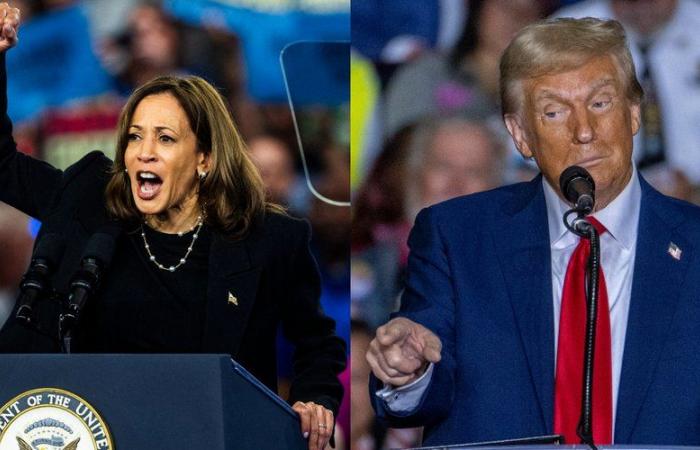
If the tenant of the White House governs a nation of more than 330 million inhabitants, the result of the American presidential election on November 5 should probably depend on barely a few tens of thousands of voters distributed among a small handful of voters. States.
The reason is simple: among the 50 American states, only seven so-called “pivot” (“Swing States”) – Arizona, Georgia, Michigan, Nevada, North Carolina, Pennsylvania and Wisconsin – are considered truly undecided this year, while the others lean clearly to the Democratic or Republican side, opinion polls show.
Among these seven states, the most populous, Pennsylvania, could decide the identity of the next President: former Republican President Donald Trump, victorious in the 2016 election, or Democratic Vice-President Kamala Harris, who would become in the event success as the first woman to sit in the Oval Office.
The strategies of both campaigns highlight this reality, as both the Harris camp and the Trump camp have invested most of their advertising budgets in these seven states and have organized multiple campaign events there.
Why is the election not decided by a national popular vote?
Unlike other federal elections and regional elections, the presidential election does not depend solely on the popular vote. The new tenant of the White House is not elected by a majority of direct universal suffrage on a national scale, but via a system known as the Electoral College: the candidate having won the most votes in a State receives the votes of the major voters of said state, the number of which is primarily based on the size of the population.
To win, a candidate must obtain a majority of votes from the Electoral College, made up of 538 electors, or 270 votes. This is possible even when being ahead of the national vote total, as was the case for Donald Trump during his victory in 2016 against Democrat Hillary Clinton.
In the event of a tie in the Electoral College, with 269 votes for two candidates, the House of Representatives – whose seats are also at stake on November 5 – is responsible for designating the winner of the vote, the delegations from each of the states then having a single vote. According to analysts, such a scenario should benefit Donald Trump.
Why are seven states the focus of attention?
Based on opinion polls in each state, without taking into account the seven pivotal states, Kamala Harris would obtain 226 electors, ahead of Donald Trump with 219 electors, but 93 electors would remain to be allocated with the “Swing States”.
While they were for a long time one “blue wall“, Democratic strongholds, Michigan, Pennsylvania and Wisconsin were narrowly won by Donald Trump in 2016, allowing the Republican to beat Democrat Hillary Clinton nationally.
These three states were taken over by Joe Biden in the previous election, during which the Democratic candidate also achieved unexpected victories in Georgia and Arizona, two states historically favorable to the Republicans.
THE “Swing States” are attracting all the more attention as the race for the White House is extremely close this year, with Kamala Harris and Donald Trump being neck and neck in voting intentions week after week. According to a New York Times tool for monitoring voting intentions, on October 16, an almost perfect equality between the two candidates emerged in the seven pivotal states, except in Arizona where Donald Trump was credited with two points of vote. percentage lead – a tiny difference, within the margin of error of polls.
The November 5 vote appears even more undecided than that of 2020. At the time, a few tens of thousands of votes could have changed everything: if 43,000 votes spread across three states had gone to Donald Trump rather than Joe Biden, whoever was the outgoing president at the time would have been re-elected to the White House.
Why is Pennsylvania so important?
The crucial role of Pennsylvania in the presidential election can be summed up in one fact: 19, as the number of electors it has, more than any other decisive state.
In a way, Pennsylvania alone is a seesaw…within a seesaw. It is considered essential for both Kamala Harris and Donald Trump to win the election, because it is seen as the state which will allow one of the candidates to cross the essential threshold of 270 electors.
To hope to win if she were to be overtaken in Pennsylvania, Kamala Harris will have to finish first in North Carolina or Georgia, two states which have voted in favor of the Democrats only three times over the last four decades.
In the event of defeat in Pennsylvania, Donald Trump will need to return to the White House to win in Wisconsin or Michigan, states they won in the 2016 presidential election – the only victory for the Republicans in these two States since the 1980s.
Both the Harris campaign and the Trump campaign view Pennsylvania as the most important state in the ballot. The two candidates made the greatest number of campaign trips there, with at the same time advertising expenditure that was out of proportion compared to other states.
According to the specialist firm AdImpact, more than $279 million was spent on television ads in Pennsylvania by the two campaigns and their allies, compared to $75 million in Michigan, the second state in this ranking.





